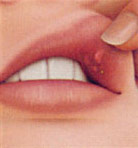
Canker Sores
Canker sores , also called aphthous ulcers (aphthae), are a common form of mouth ulcer, caused by a break in the mucous membrane (mucosa) of the mouth. The condition, also known as aphthous stomatitis, is characterized by recurrent ulcers which are almost always painful.
What is a Canker Sore ?
A canker sore is a shallow, painful, open sore in the mouth. They usually appear on the inner surface of the cheeks and lips, soft palate, the base of the gums and on or under the tongue. Canker sores can be very painful and they can make eating and talking uncomfortable.
Recurrent aphthous stomatitis is one of the most common inflammatory conditions of the mouth. About 10-20 percent of the population suffers from canker sores. Women are more often affected than men and about 30–40% of patients with recurrent canker sores report a family history. They may occur at any age, but usually first appear between the ages of 10 and 40.
Canker sores usually go away on their own in 7 - 10 days.
Are canker sores contagious ?
Canker sores should not be confused with cold sores. Canker sores are not contagious, whereas the cold sores caused by the herpes simplex virus are highly contagious. Cold sores can be easily distinguished, as they usually form on the outside of mouth around and on the lips and not inside the mouth like a canker sore.
 If a canker sore persists for more than two weeks, you should see your dentist.
If a canker sore persists for more than two weeks, you should see your dentist.
In rare cases, a mouth cancer may first look like a mouth ulcer that does not heal.
Canker Sore Symptoms • What do canker sores look like?

Early symptoms of a canker sore could often be a tingling or burning sensation at the area where the aphthous mouth ulcer is about to appear. In a few days, they often progress to form a small reddish oval or round swelling (small bump or red spot). This swelling usually ruptures within a day, developing an open sore.
A canker sore in the mouth is usually white, yellow or light grey and surrounded by a red border. Sometimes a white circle or halo can be observed around the lesion.
Cankers are often extremely painful, especially when agitated. Pain decreases in 7 to 10 days, with complete healing in 1 to 3 weeks, depending on the size of the aphthous ulcer. Unfortunately, canker sores commonly come back.
what does a canker sore look like
Canker sores occur in several forms:
- Minor canker sores are oval and less than 10 mm (1/3 inch) across. They are very painful but clear up within 3-14 days.
- The major form consists of deep ulcers measuring greater than 1 cm (1/3 inch). These severe canker sore forms may take longer to heal and could leave scars after healing.
- Another form of canker sores look like herpes infections and consist of many small punched-out lesions, 1-3 mm in diameter, or less than one-tenth inch. Clusters of these sores may merge together to form large irregular ulcers.
Less common symptoms include fever, general discomfort or uneasiness, swollen lymph nodes
If you need more info on what does a canker sore look like, click here for pictures of canker sores.
What Causes Canker Sores?
While the exact cause of canker sores is unknown, there are many conditions which can lead to ulceration of the oral mucosa.
Researchers believe that the following risk factors are involved in developing canker sores :
- Trauma - minor physical injuries. Physical trauma to the mouth is a common cause of cankers sores. Possible conditions that can cause mouth ulcers by breaking the mucous membrane are :
- Injury from accidentally biting the cheek, lips or tongue
- Chewing sharp bits of food
- Dental or orthodontic appliance (as dental braces) or a sharp edged tooth rubbing against the cheek
- Poorly fitting dentures
- Toothbrushing with a hard toothbrush
These ulcers usually heal rapidly if the source of the injury that caused the canker sore is removed. - Chemical agents. Chemicals such as aspirin or alcohol (when they stay in contact with the oral mucosa) may damage mouth tissues creating an ulcer. Other factors, such as chemical irritants or thermal injury, may also lead to the development of ulcers. Sodium Lauryl Sulfate (SLS), a foaming agent that is one of the main ingredients in most toothpastes, is known to cause aphthous ulcers in certain cases.
- Infection - Viral, fungal and bacterial infections can lead to oral ulceration and cause canker sores.
- Immune system - Autoimmunity. In some cases canker sores are thought to be caused by an overreaction by the body's own immune system. A common cause of ulcers is Coeliac disease, a disease caused by sensitivity to gluten, in which case consumption of wheat, rye, or barley can result in chronic oral ulcers. Immunodeficiency is another possible cause of canker sores. Chemotherapy and HIV, both causes of immunodeficiency, have the creation of mouth ulcers as a side effect or symptom. Mouth ulcers may also be symptoms or complications of several other diseases related to immunodeficiency.
- Allergy - Several food allergies can lead to ulcerations of the mucosa.
- Dietary causes - Dietary deficiencies of vitamin C, vitamin B12, iron, zinc and folic acid, may contribute to some cases of mouth ulcers. Too much ascorbic acid (vitamin C) or citric acid may also cause canker sores. Artificial sugars such as those found in diet cola and sugarless gum, have been reported as what causes cankers as well. Certain foods – including acidic fruits and vegetables (such as lemons, oranges, pineapples, apples, figs, tomatoes, citrus, strawberries) – can trigger a canker sore or make the problem worse.
- Genetic reasons – Epidemiological data that show cankers sores to be a common problem among members of the same family, suggest that there may be a genetic predisposition for canker sores.
- Oral Cancer - Ulcerations at the first stage of oral cancers may resemble to a common canker sore.
- Stress - If the sores tend to show up during stressful periods in your life, it may be a sign of a connection between canker sores and stress.
- Hormonal changes / menstruation – The fact that about twice as many women as men suffer from canker sores, and especially more often during menstrual periods, has led doctors to relate some cases of aphthous ulcers with hormonal factors
When should you ask medical advice for canker sores in mouth?
You should consult with your doctor or dentist in case of :
- Persistent canker sore (or any other inflammation of the mouth) that lasts or worsens for more than two or three weeks, as this could be a warning sign of oral cancer.
- The canker sore is unusually large, or the pain is too intense.
- High fever accompanies the sores.
- You experience difficulty drinking or chewing because of the sores.
In such cases, the canker sore may be a sign of some other (possibly serious) medical condition. A dentist (or doctor) can diagnose and recognize the type of aphthous ulcer in your mouth based on its location and morphology. Then they will suggest the proper treatment and possible prevention measures.
Also if you have sharp tooth surfaces or dental appliances that possibly cause the sores, it is a good idea to visit your dentist to correct them in order to prevent canker sores in the future.
![]() The cost involved with dental treatments can be significant and many patients may not afford it if they are not covered by their dental insurance.
Learn how to choose a dental insurance plan that will provide the best dental treatment to you and your family.
The cost involved with dental treatments can be significant and many patients may not afford it if they are not covered by their dental insurance.
Learn how to choose a dental insurance plan that will provide the best dental treatment to you and your family.


